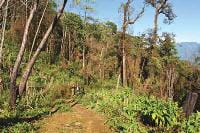
Articles
Speaking up for forests and livelihoods
In South-East Asia, as part of a larger dam-building project, a government and foreign companies are planning to build a dam at the meeting point of two rivers
2011 Available in English, French, Portuguese and Spanish

From: Trees – Footsteps 85
How to look after trees and make the most of the many benefits they bring

Forest in South-East Asia. Photo: Andrew Philip/Tearfund
Speaking out against a dam construction project
In South-East Asia, as part of a larger dam-building project, a government and foreign companies are planning to build a dam at the meeting point of two rivers. This place is rich in biodiversity and has great cultural significance for the people that live there. The project involves flooding a large area of forest and relocating 60 villages, affecting around 15,000 people. These families will no longer be able to provide for themselves and raise income through farming, fishing and gathering non-timber forest products (useful things the forest provides that do not require the cutting down of trees). One such village has 2,000 acres of rubber plantations, 300 acres of mixed fruit orchards and 200 acres of orange orchards. These have been established for 20 years.
Many people are speaking out against the construction of the dam. The purpose of the dam is to create energy for electricity, which is needed in the area. Although compensation has been offered, villagers do not believe it represents the value of what will be lost. There are no proper resettlement plans. Villagers are appealing to the government, saying that the productivity of their farms, which has taken many years to develop, will be lost.
This situation has not yet been resolved and plans for the dam continue.
With thanks to the Kachin Development Networking Group for permission to use their research.
Working together to protect the Amazon rainforest
The people of Amazanga, Ecuador, did not always live where they do now. An oil spill forced the members of the Quichua tribe to move from their traditional land in the Amazon. When their new homes were threatened by deforestation and industrial farming, the villagers decided that managing their lands according to the traditions of their people – hunting, fishing, and gathering plants for food and medicine – was the best way to protect their lands.
But this required more land than they had. Amazanga demanded that the government grant them territory to live as their ancestors had lived. ‘We cannot live from a piece of land like a piece of bread,’ they said. ‘We are talking about territory, and the right to live well from the forest.’ When the government ignored their demand, they asked international environmental groups for help in buying back their ancestral lands.
The villagers invited their international partners to take photographs and videotapes showing traditional ways of using the forest, and to share these with people in their home countries. After several years, Amazanga raised enough money to buy almost 2,000 hectares of forest.
However, buying this much land created suspicion among members of the Shuar tribe who lived nearby. When the Shuar claimed ownership of the same land, the people of Amazanga understood they had made a mistake. They had built partnerships with international organisations, but had failed to make agreements with their neighbours! The Shuar were so angry they threatened violence. After many meetings, the people of Amazanga and the Shuar agreed to share the forest according to shared rules. Because the Quichua and the Shuar have similar understandings of how best to use the forest, they were able to form an alliance.
They made the land a forest preserve and agreed to a forest management plan preventing the felling of trees and building of roads. The land was declared ‘patrimony of all the indigenous tribes of the Amazon’ and protected for future generations. By reaching out to visitors from near and far, the people of Amazanga will protect the forest, preserve their culture, and help others to protect their own forest homes.
This case study has been taken from A Community Guide to Environmental Health, with thanks to the publishers, Hesperian, for permission.
Discussion
- Do you know of any similar situations in your region? If so, what can be done?
Similarly Tagged Content
Share this resource
If you found this resource useful, please share it with others so they can benefit too.

Subscribe to Footsteps magazine
A free digital and print magazine for community development workers. Covering a diverse range of topics, it is published three times a year.
Sign up now - Subscribe to Footsteps magazine





